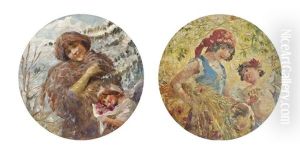Carlo Grossi Paintings
Carlo Grossi was an Italian painter and engraver who lived during the Baroque period. He was born in 1652 in Venice, Italy, a city renowned for its artistic vibrancy and significant contributions to the art world during the 17th and 18th centuries. Grossi's life and work were deeply influenced by the rich cultural milieu of Venice, where he spent the majority of his life.
Grossi was not as widely recognized as some of his contemporaries, such as Giovanni Battista Tiepolo or Canaletto, but he still contributed to the Venetian artistic landscape with his unique style and technique. His work mainly consisted of religious themes, which was typical for the period, and he was known for his use of vivid colors and dynamic compositions that reflected the opulence and drama of the Baroque era.
Although specific details about his training and early career are not well-documented, it is likely that Grossi was influenced by the works of other Venetian masters. His paintings can be characterized by a certain fluidity in brushwork and an attention to detail, which were hallmarks of the Venetian school.
Carlo Grossi's career unfolded during a time when Venice was transitioning from its golden age of the 16th century to a period of gradual decline in political and economic power. Despite this, the arts continued to flourish, and Grossi's work is an example of the enduring creative spirit of the city. He remained active as an artist until his death in 1728 in Venice.
Today, Carlo Grossi's works are less known to the general public and are overshadowed by the grand masters of the era, but they remain of interest to art historians and collectors who specialize in the period. His paintings can be found in various churches and private collections, mainly in Italy, and they continue to be studied for their contribution to the Baroque period of Venetian art.



